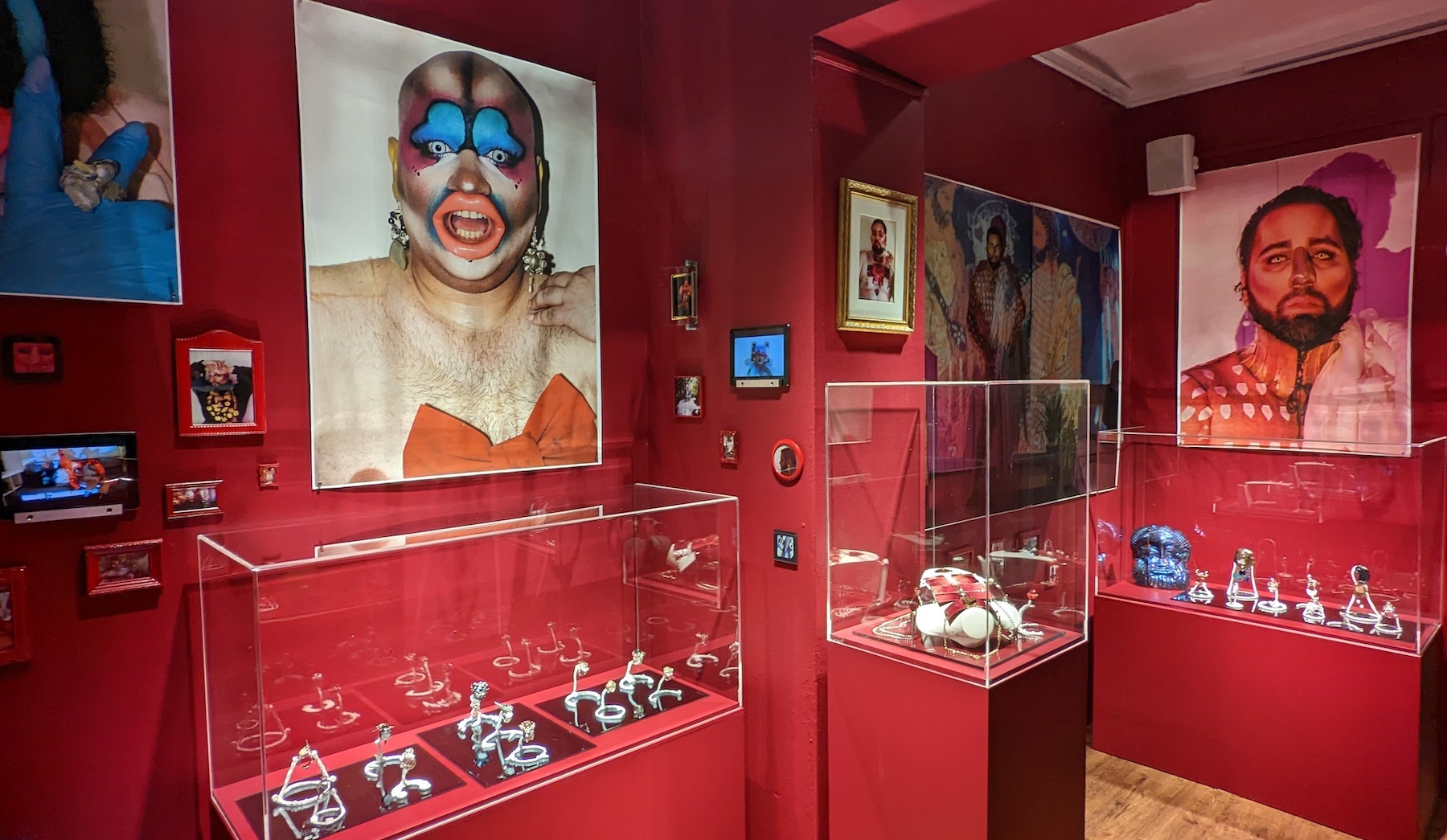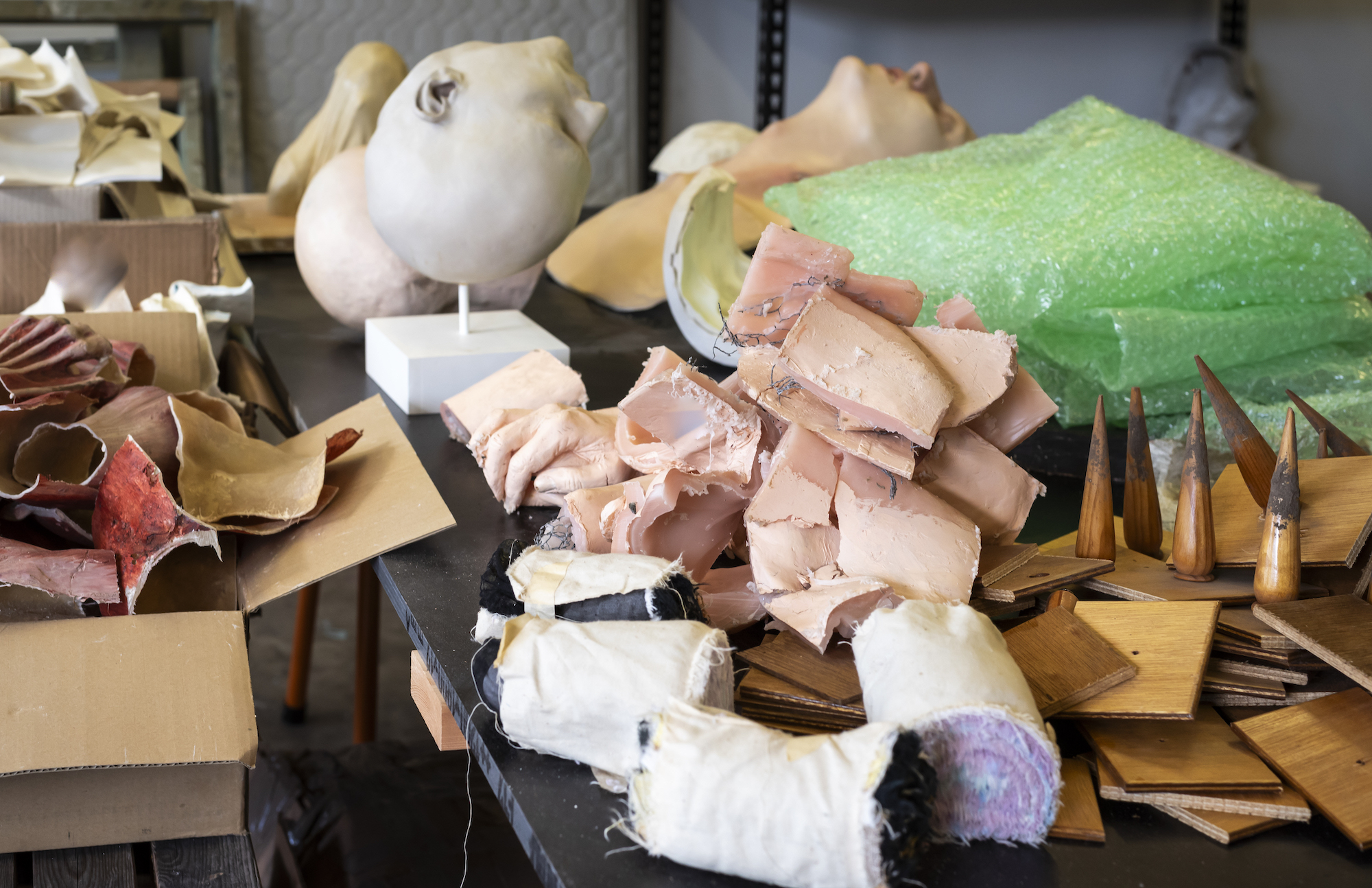Peep Show feels at home in The Vault at Bundaberg Regional Art Gallery: stashed away around the corner, at the back of the gallery, through a door requiring crouching to enter. The Vault is a room battling its own tedious history as a bank vault in a regional town, and Anderson does as much to free the space of its material conditions as one could, highlighting the excitement of secrecy and privacy and the seduction of exchange contained within its walls. The old vault’s reinforced and deep red walls are adorned with photographs in keepsake frames of a variety of sizes, touchscreens with looping video performances, and vibrant energetic large prints of the artist in costume. In addition to this mix, works of jewellery, hand-drawn animation and projection bleed into one another creating a whole-room installation.
Anderson’s practice is object led; his works start with a piece of jewellery or costuming made by the artist. These charged pieces influence the artist’s movements, makeup, and demeanour in consequent photographic and video works. In turn, Peep Show is an exploration of identity as always-under-construction. The idea of identity as “in-progress” may suggest a linear mode from start to completion, however that doesn’t explain the works here. Anderson’s project presents identity as an act of conjuring, as slippery, attainable only temporarily or viewed peripherally, like something seen in the water. The artist uses semi-precious stones, metals, theatre and makeup to achieve this conjuring: baroque rings, breast plates and pendants, evidencing hours and years of craftsmanship, feel trapped behind his Perspex casings.
The small scale of some of Anderson’s works dictate a one-on-one viewing experience. Some are low to the ground. And although viewing them feels up close and personal, like peering through a keyhole, my gaze is often met by the artist’s. This complicates the viewer’s voyeuristic position and the anonymity that a peep-show premise might suggest. Other images loom large in the space, intense portraits gaze down on me from a height, as if I am the one on show.
In the days following my visit, my thoughts rest steadily on Anderson’s intention, shared in the exhibition text, of tearing temporary holes in the homogeneity of daily life. Putting his own self on the line, Anderson seeks to break through this monotony by allowing himself to be seen and by thrusting the viewer into the position of voyeur. In doing so, Anderson drums up the ever-present anxiety of seeing and being seen—a twinned condition from which we cannot seem to opt out: If I do not wish to be seen, if I do not wish to see, I guess that’s too bad.
The highlight of the exhibition are small screen video works filmed in the home, testing these porous boundaries of visibility. Anderson moves slowly in these mesmerising and multi-layered shots, wearing replicas of his own face or moving through a projection of himself that fills the room like a veil of smoke, creating an effect that comes close to a kind of self-mimicry-camouflage. With multiple images of the artist playing on these screens simultaneously, overlapping and interacting with one another, these works create worlds within themselves. They are visual warrens with a strong ambience that is both exciting and foreboding.
The precision and magnetism of the artist’s performance in Public Mountain (2018) is offset by the backdrop of an all-too-familiar Ikea futon. I’m reminded of a stereogram, a magic eye, of seeing something illusory, fleeting, almost other-worldly, then having the image slip back into a sea of everything else.
Anderson’s central preposition, the use of the peep-show archetype to create moments of psychic respite from everyday life, gains momentum, strength and ultimately finds success in these performances, but they also highlight the fault in our contemporary need, created by social media, for a remediated reality. The impermanence of these moments prompts questions about the nature of this exchange. If we embark on the act of doing identity, then on whose terms do we perform and to what end? Anderson turns to alchemy to liberate the viewer from the drudgery of the day to day. This is the altruism of artists, and something we expect, but this feels too simple an explanation for Anderson’s performance. What is this spectre of homogeneity that Anderson refers to? Does he really offer the viewer reprieve from the condition of contemporary sameness or does he double down on it by mirroring the proliferation of self/images and our forced positions as voyeurs? As these questions percolate I come to realise that by flipping between predator and prey, like so much camouflage in nature, Anderson’s work complicates the one-way transaction of the peep show.
Bringing the act of being seen into the home, where it undeniably cohabitates with us against our will, suggests that being seen, and the culture of identity-as-currency, is perhaps the true monotony. Anderson’s work reveals the pervasive expectation that you will, in perpetuity and always for someone else’s pleasure, turn it on and offer it up on your marle-grey Lycksele sofa.
Molly Smith is a multidisciplinary artist and writer living and working in Meanjin.







